Sir John Monash, Personal Files Book 16, 1 August - 3 September 1917, Part 12
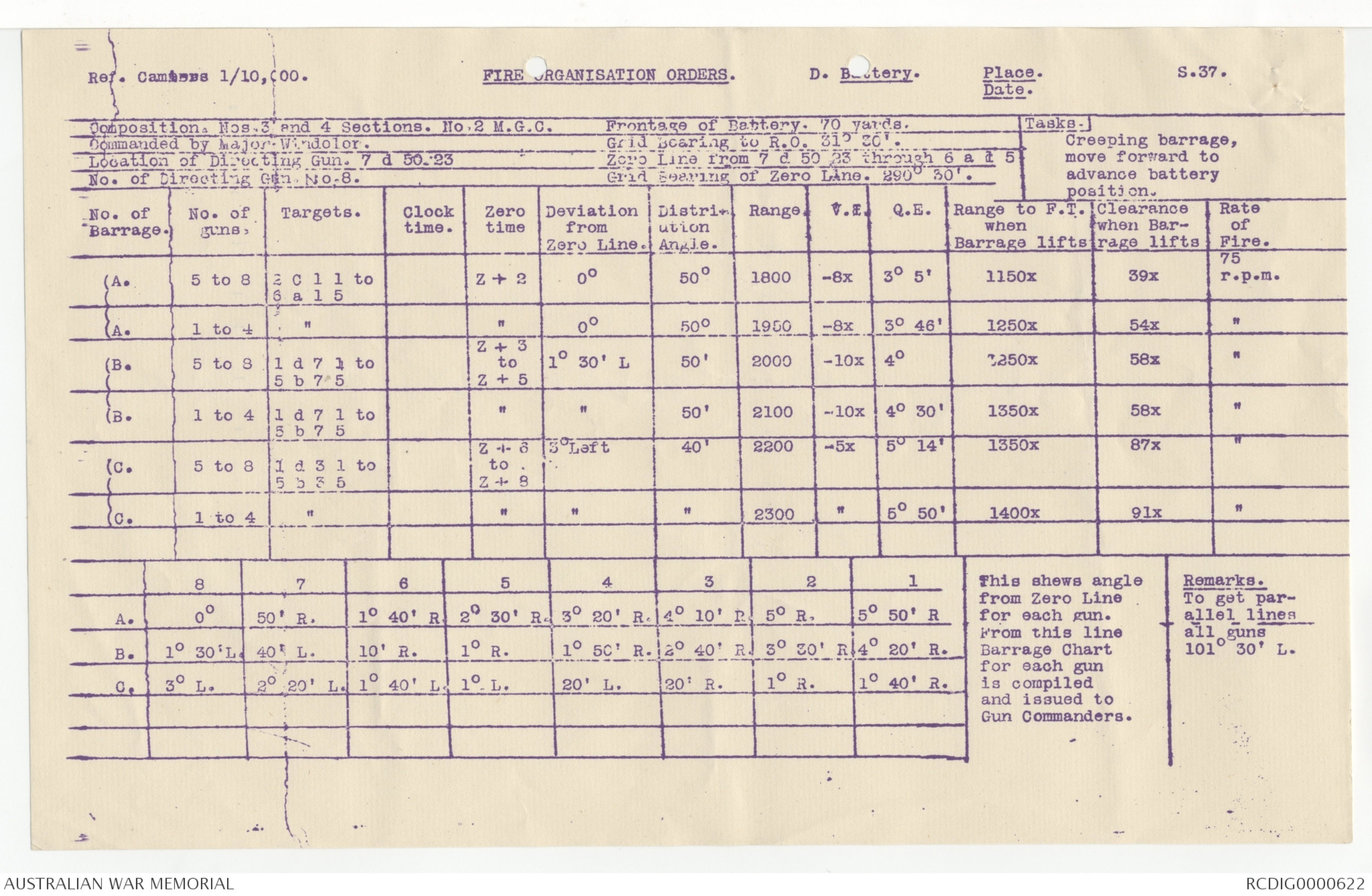
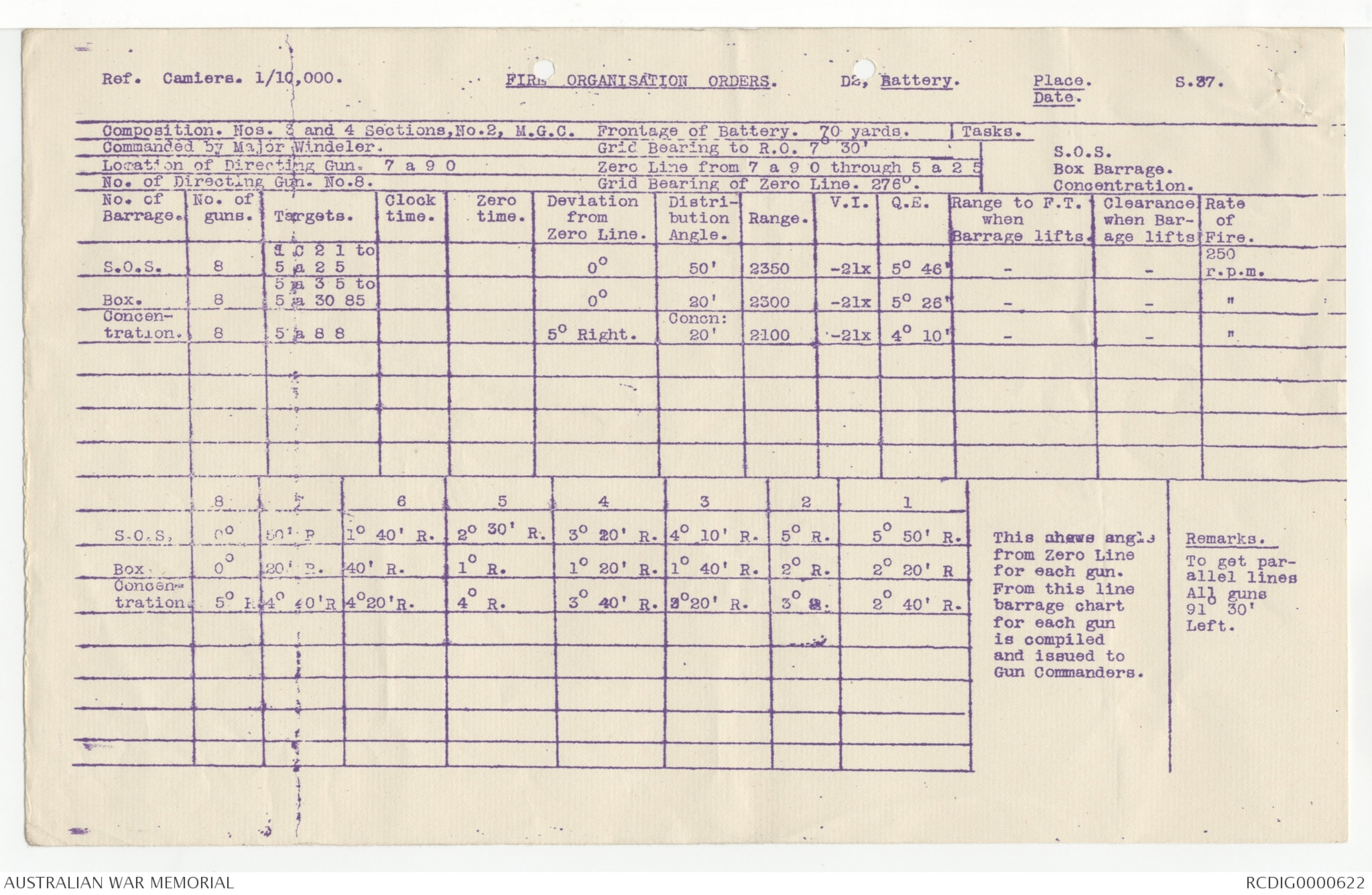
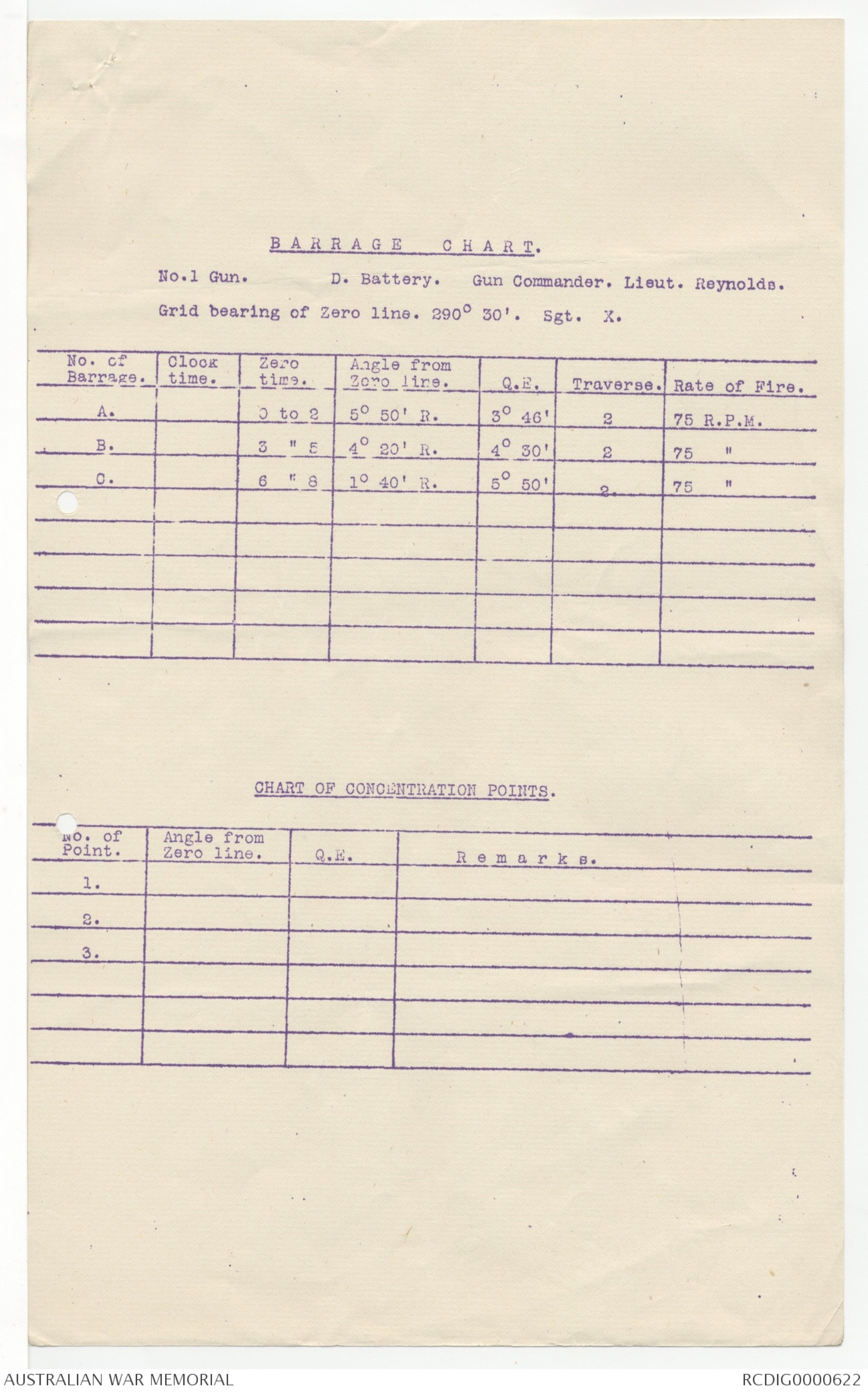
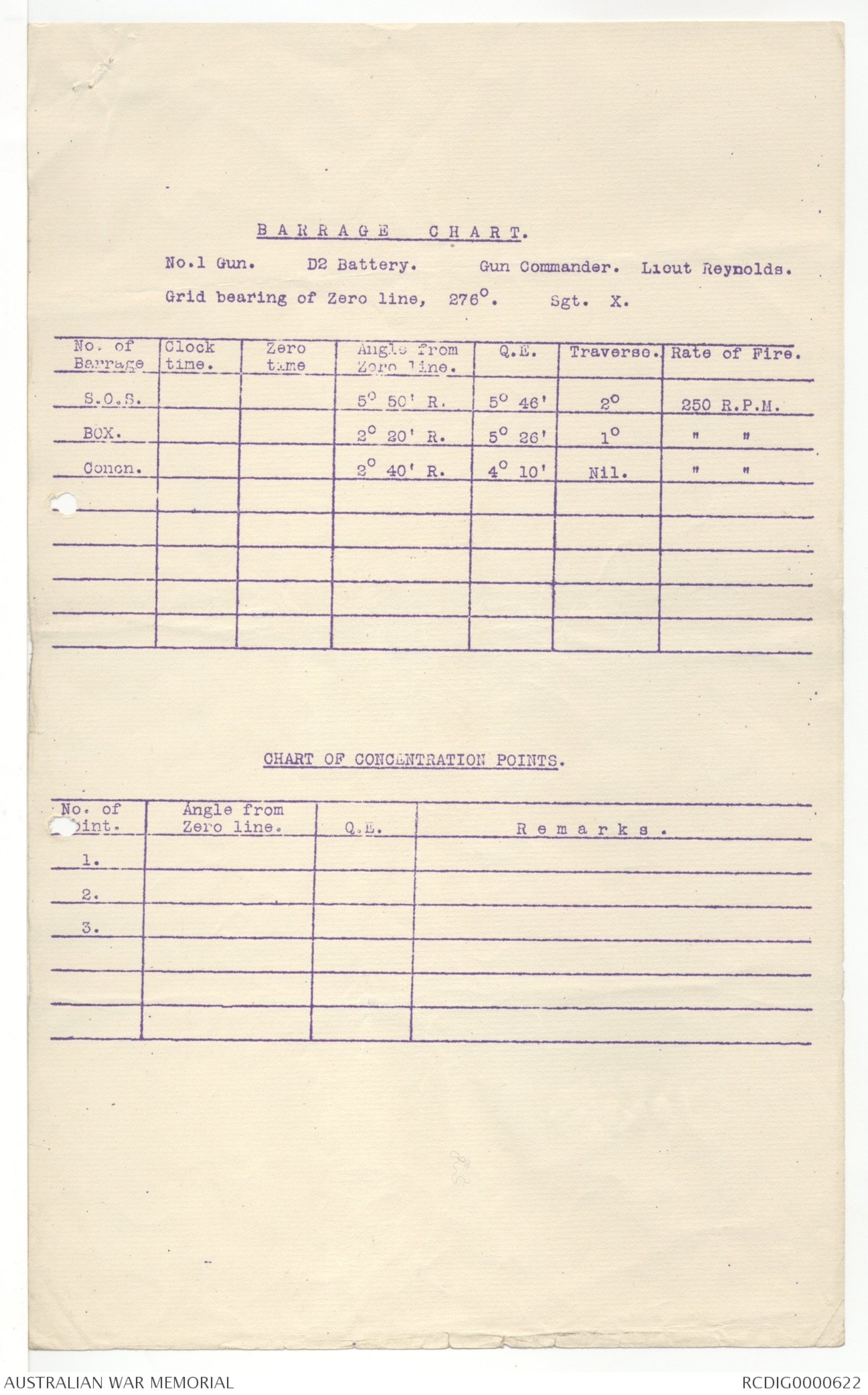
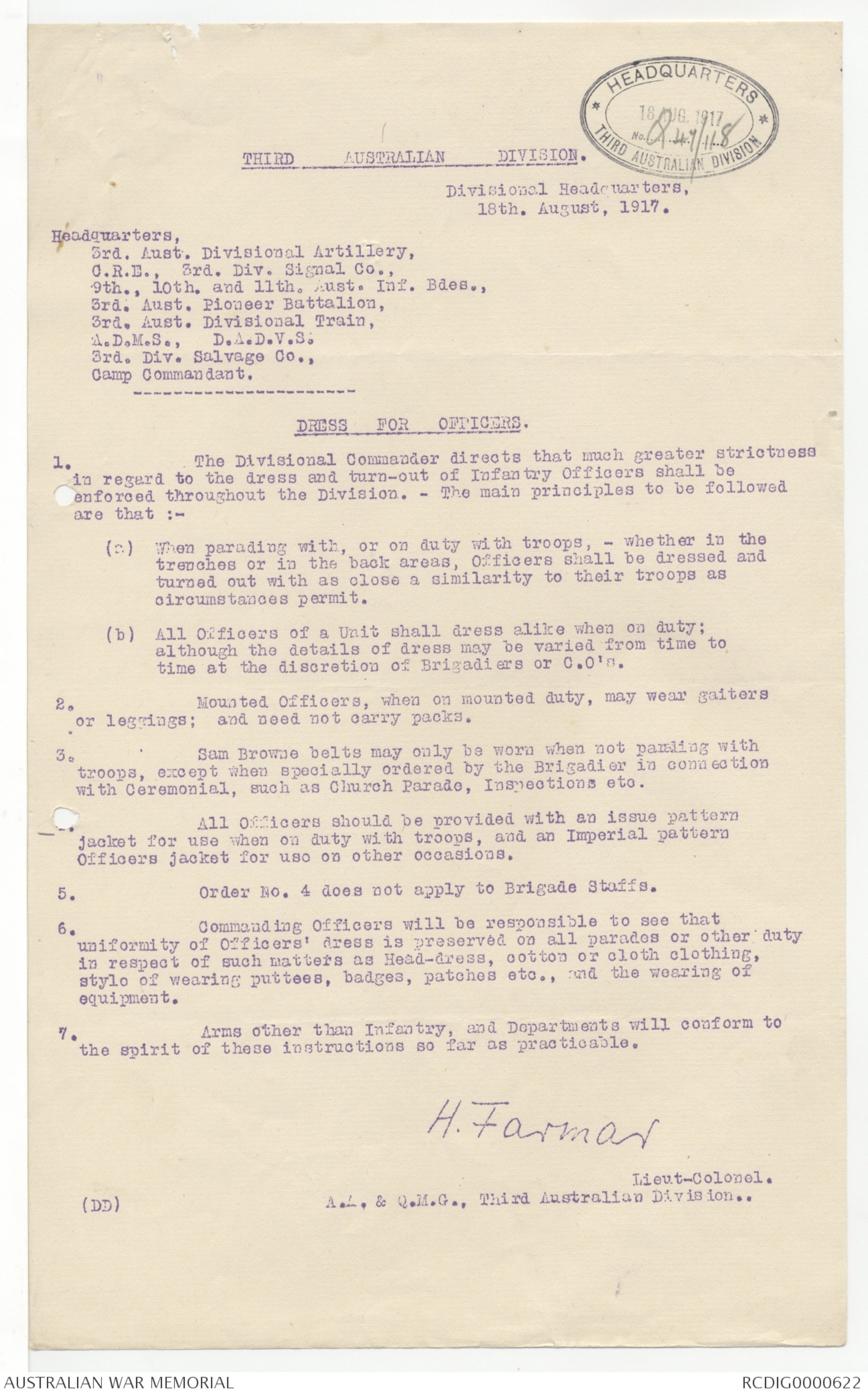
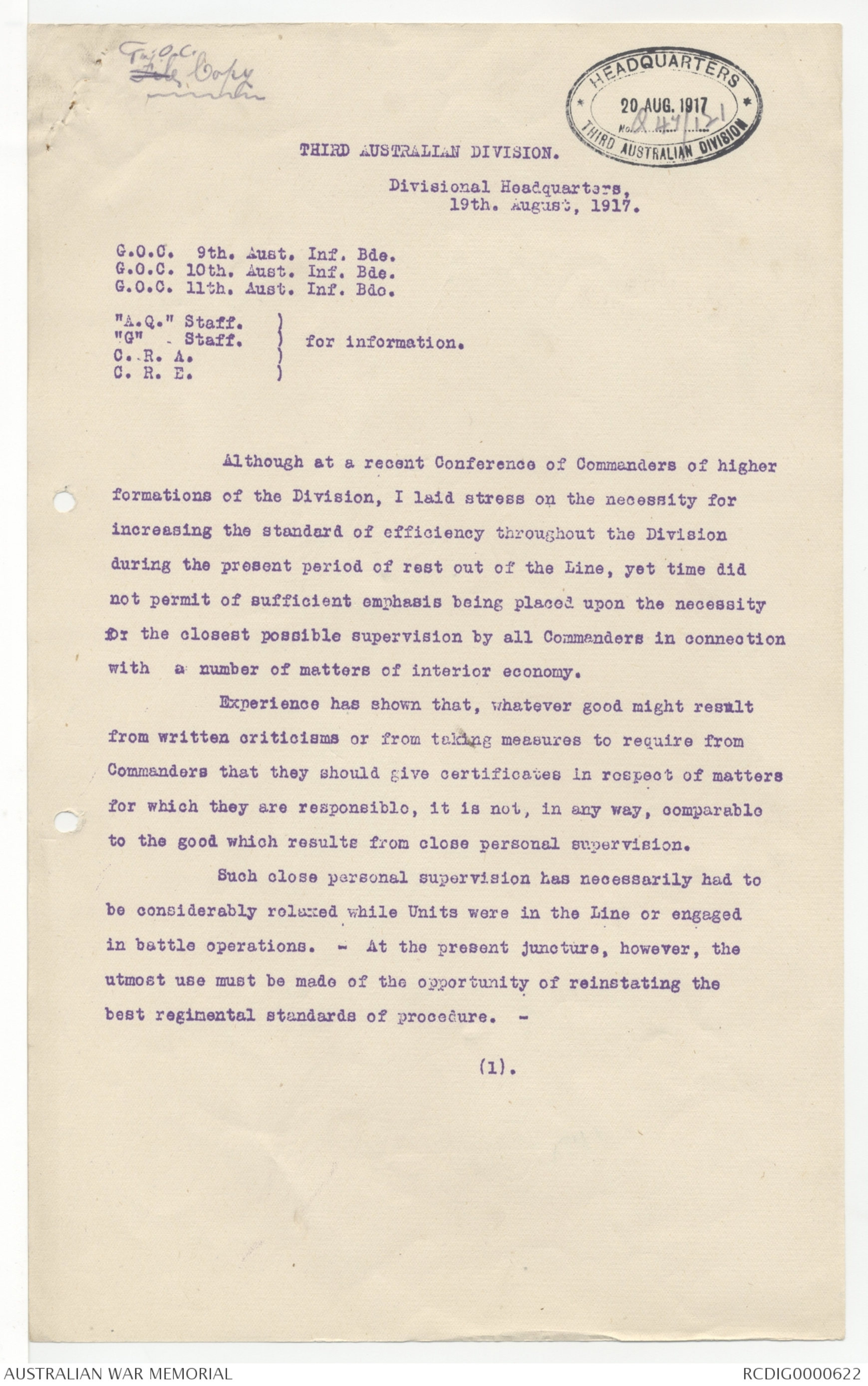
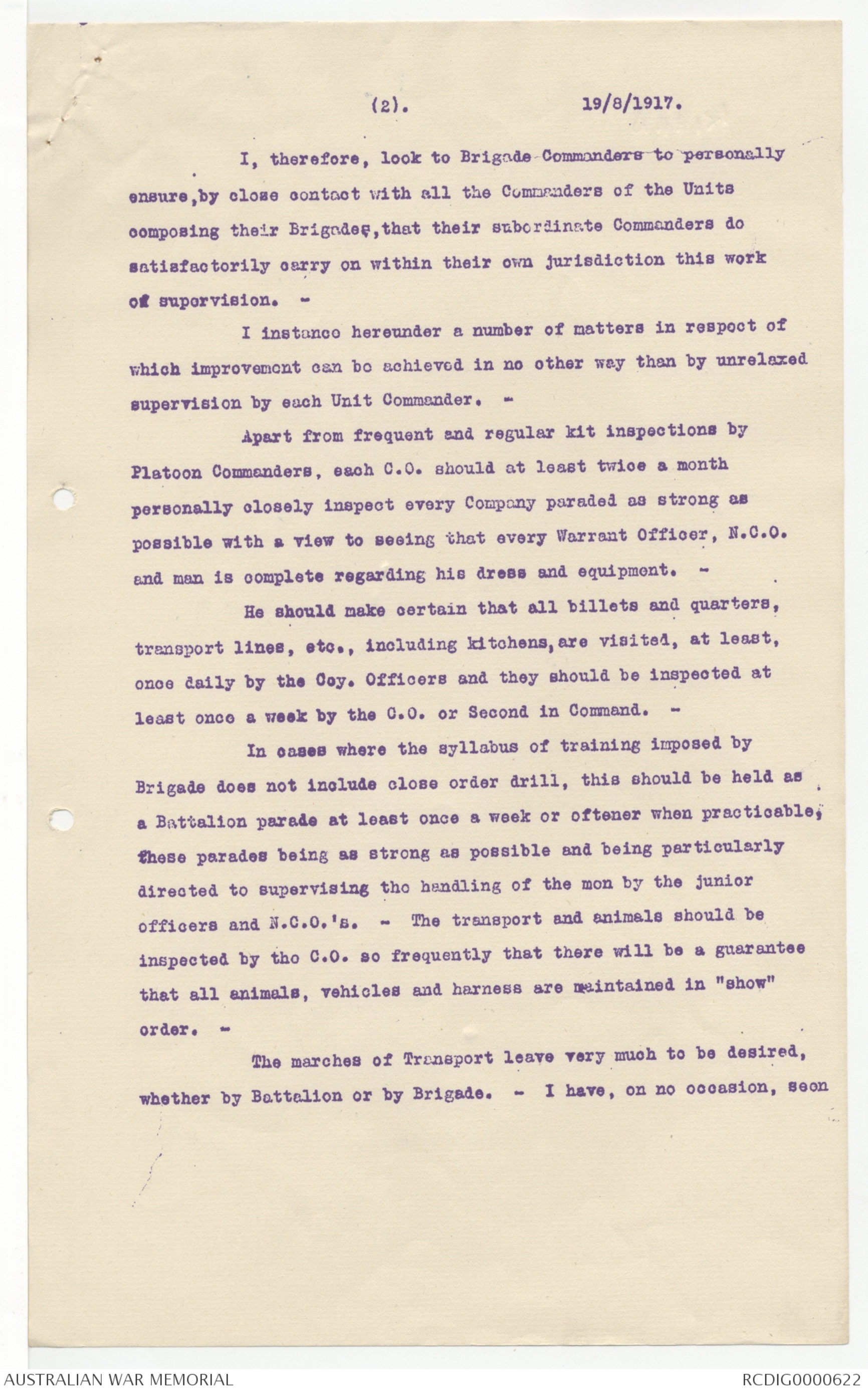
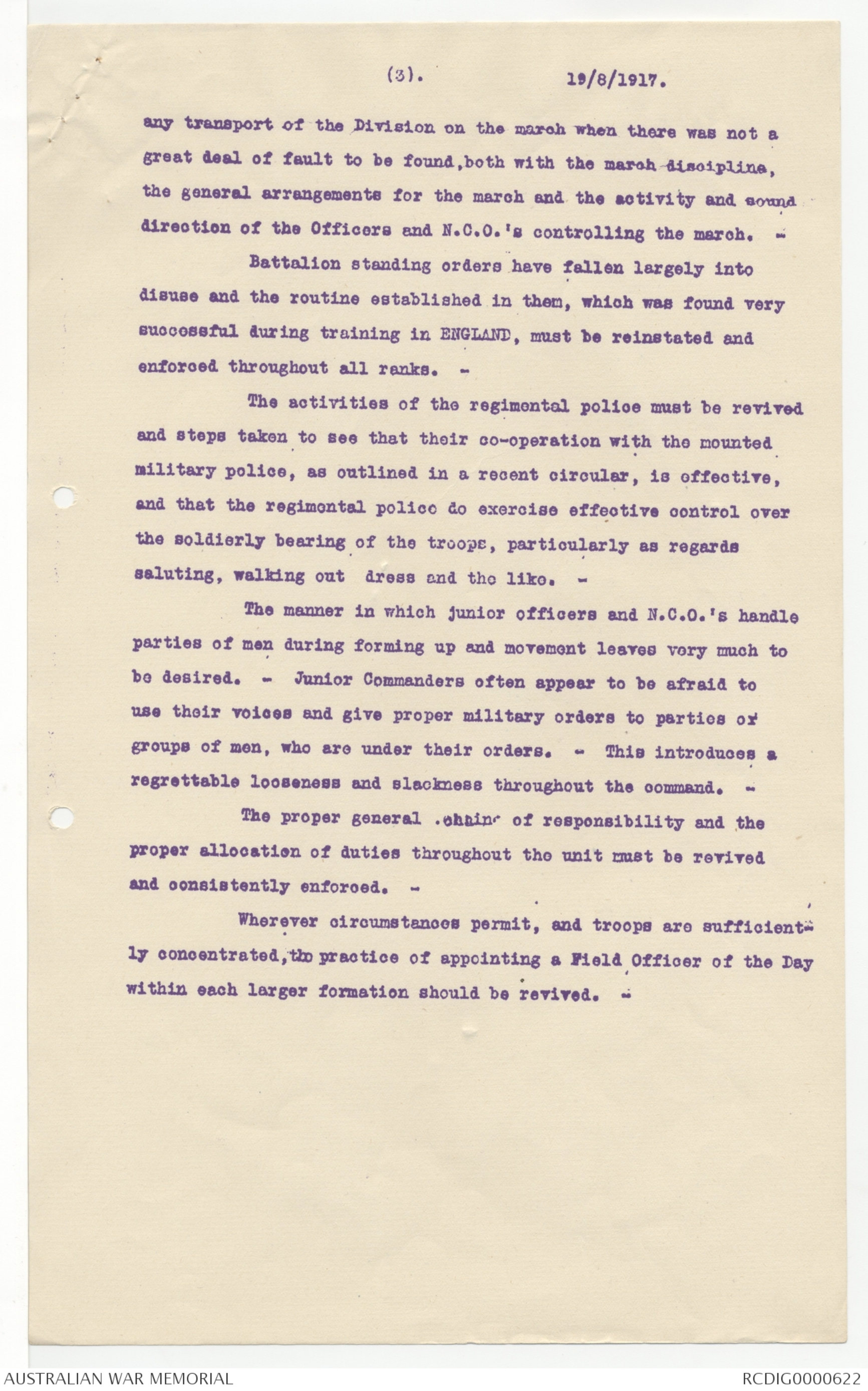
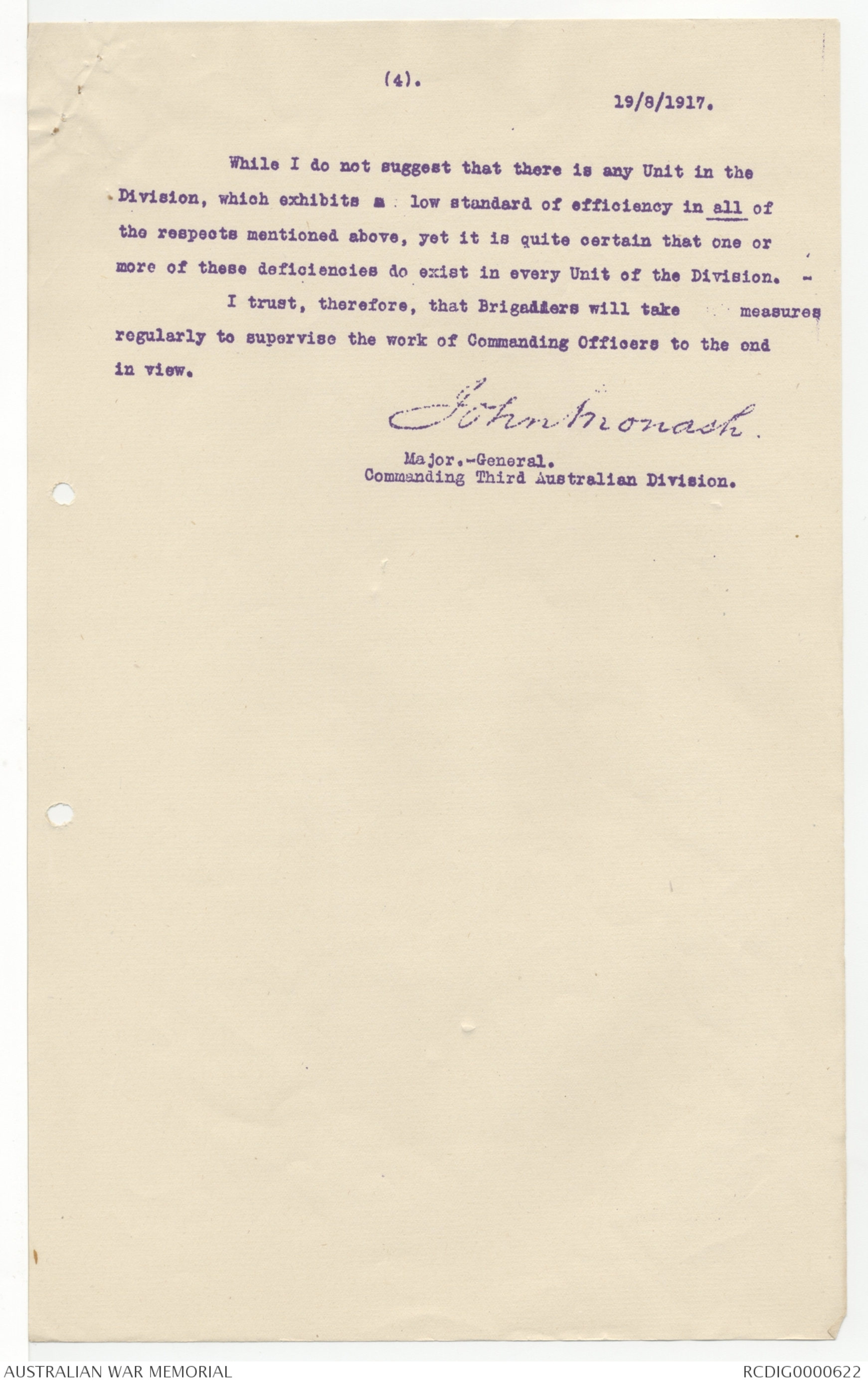
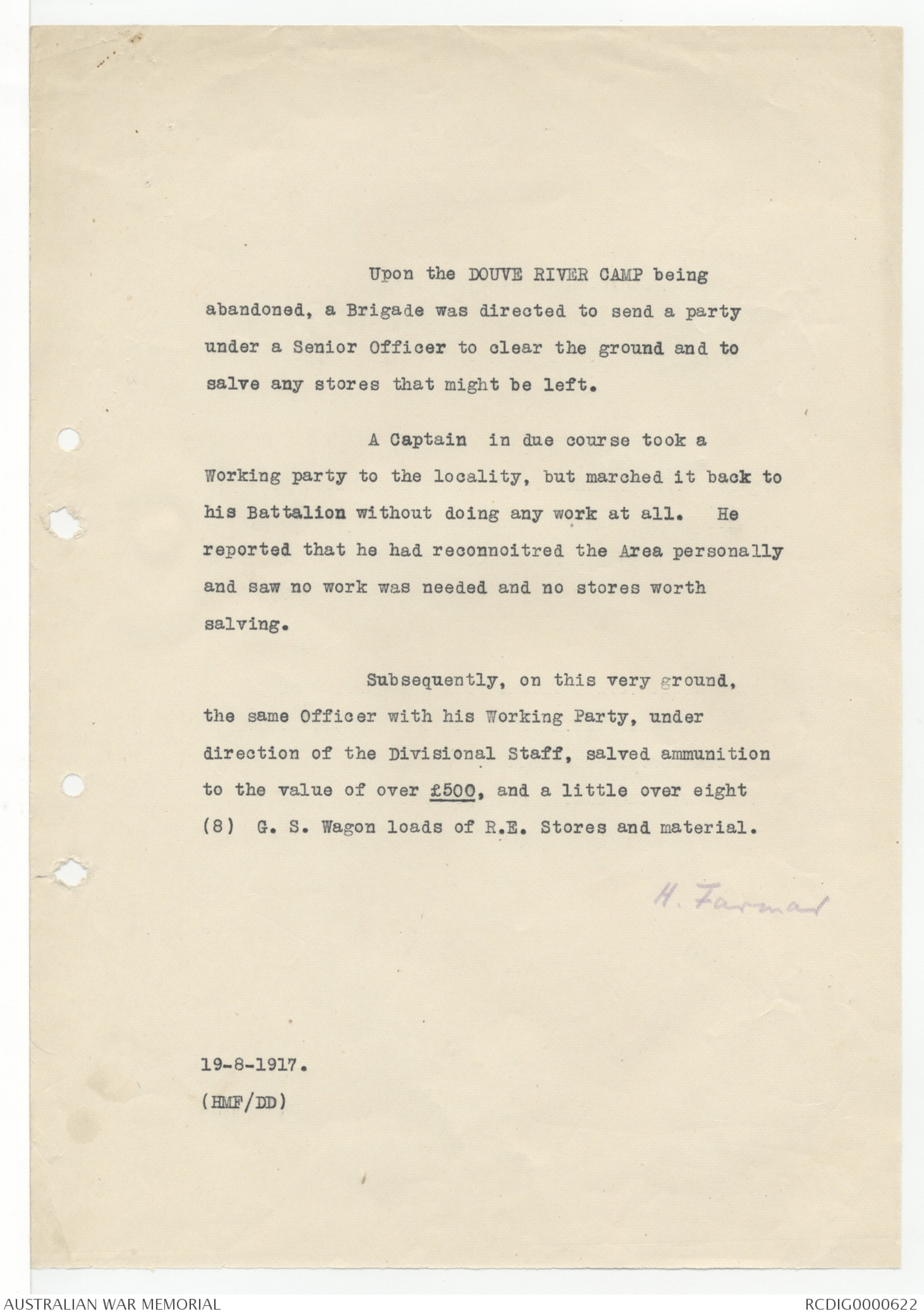
| Ref. Camieres 1/10,000. | FIRE ORGANISATION ORDERS. | D. Battery. | Place. | S. 37 | ||||||||
| Date. | ||||||||||||
| Composition. Nos.3 and 4 Sections. No.2 M.G.C. | Frontage of Battery. 70 yards. | Tasks - | ||||||||||
| Commanded by Major Windolor. | Grid Bearing to R.O. 31o 30' |
Creeping barrage, move forward to advance battery |
||||||||||
| Location of Directing Gun. 7 d 50.23 | Zero Line from 7 d 50 23 through 6 a |
|||||||||||
| No. of Directing Gun. No.8. | grid Bearing of Zero Line. 290o 30' | |||||||||||
| No. of Barrage. |
No. of Guns. |
Targets. | Clock Time. |
Zero time |
Deviation from Zero Line. |
Distri- ution Angle. |
Range. | V. |
Q.E. | Range to F.T. when Barrage lifts |
Clearance when Barrage lifts |
Rate of Fire. |
|
(A. |
5 to 8 |
2 C 1 1 to |
|
Z + 2 |
0o |
50o |
1800 |
-8x |
3o 5' |
1150x |
39x |
75 |
|
( |
1 to 4 |
" |
|
" |
0o |
50o |
1950 |
-8x |
3o 46' |
1250x |
54x |
" |
|
(B. |
5 to 8 |
1 d 7 1 to |
|
Z + 3 |
1o 30' L |
50' |
2000 |
-10x |
4o |
1250x |
56x |
" |
|
( |
1 to 4 |
1 d 7 1 to |
|
" |
" |
50' |
2100 |
-10x |
4o 30' |
1350x |
58x |
" |
|
(C. |
5 to 8 |
1 d 3 1 to |
|
Z + 6 |
3o Left |
40' |
2200 |
-5x |
5o 14' |
1350x |
87x |
" |
|
( |
1 to 4 |
" |
|
" |
" |
" |
2300 |
" |
5o 50' |
1400x |
91x |
" |
|
|
8 |
7 |
6 |
5 |
4 |
3 |
2 |
1 |
This shews angle |
Remarks.
|
|
A. |
0o |
50' R. |
1o 40' R. |
2o 30' R. |
3o 20' R. |
4o 10' R. |
5o R. |
5o 50' R. |
||
|
B. |
1o 30' L. |
40' L. |
10' R. |
1o R. |
1o 50' R. |
2o 40' R. |
3o 30' R. |
4o 20' R. |
||
|
C. |
3o L. |
2o 20' L. |
1o 40' L. |
1o L. |
20' L. |
20' R. |
1o R. |
1o 40' R. |
||
| Ref. Camieres 1/10,000. | FIRE ORGANISATION ORDERS. | D2, Battery. | Place. | S. 37 | ||||||||
| Date. | ||||||||||||
| Composition. Nos. 3 and 4 Sections, No.2 M.G.C. | Frontage of Battery. 70 yards. | Tasks - | ||||||||||
| Commanded by Major Windeler. | Grid Bearing to R.O. 7o 30' | S.O.S. Box Barrage. Concentration. |
||||||||||
| Location of Directing Gun. 7 a 9 0 | Zero Line from 7 a 9 0 through 5 a 2 5 | |||||||||||
| No. of Directing Gun. No.8. | Grid Bearing of Zero Line. 276o . | |||||||||||
| No. of Barrage. |
No. of Guns. |
Targets. | Clock Time. |
Zero time. |
Deviation from Zero Line. |
Distri- bution Angle. |
Range. | V.I. | Q.E. | Range to F.T. when Barrage lifts |
Clearance when Barrage lifts |
Rate of Fire. |
| S.O.S. | 8 | 1 C 2 1 to 5 a 2 5 |
0o | 50' | 2350 | -21x | 5o 46' | 250 r.p.m. |
||||
| Box. | 8 | 5 a 3 5 to 5 a 30 85 |
0o | 20' | 2300 | -21x | 5o 26' | " | ||||
| Concen- tration. |
8 | 5 a 8 8 | 5o Right. | Concn: 20' |
2100 | -21x | 4o 10' | " | ||||
| 8 | 7 | 6 | 5 | 4 | 3 | 2 | 1 | This shews angle from Zero Line for each gun. From this line Barrage Chart for each gun is compiled and issued to Gun Commanders |
Remarks.
|
|
| S.O.S. | 0o | 50' R. | 1o 40' R. | 2o 30' R. | 3o |
4o 10' R. | 5o R. | 5o 50' R. | ||
| Box. | 0o | 20' R. | 40' R. | 1o R. | 1o 20' R. | 1o 40' R. | 2o R. | 2o 20' R. | ||
| Concen- tration |
5o R. | 4o 40' R. | 4o 20' R. | 4o R. | 3o 40' R. | 3o 20' R. | 3o R. | 2o 40' R. | ||
BARRAGE CHART.
No.1 Gun. D. Battery. Gun Commander. Lieut. Reynolds.
Grid bearing of Zero line. 290o 30'. Sgt. X.
| No. of Barrage. |
Clock time. |
Zero Time. |
Angle from Zero line. |
Q.E. | Traverse. | Rate of Fire. |
|
A. |
0 to 2 | 5o 50' R. | 3o 46' |
2 |
75 R.P.M. | |
|
B. |
3 " 5 | 4o 20' R. | 4o 30' |
2 |
75 " | |
|
C. |
6 " 8 | 1o 40' R. | 5o 50' |
2. |
75 " |
CHART OF CONCENTRATION POINTS.
| Point. | Angle from Zero line. |
Q.E. | Remarks. |
| 1. | |||
| 2. | |||
| 3. |
BARRAGE CHART.
No.1 Gun. D2. Battery. Gun Commander. Lieut. Reynolds.
Grid bearing of Zero line. 276o. Sgt. X.
| No. of Barrage. |
Clock time. |
Zero Time. |
Angle from Zero line. |
Q.E. | Traverse. | Rate of Fire. |
| S.O.S. | 5o 50' R. | 5o 46' | 2o | 250 R.P.M. | ||
| BOX. | 2o 20' R. | 5o 26' | 2o | " " | ||
| Concen. | 2o 40' R. | 4o 10' | Nil. | " " |
CHART OF CONCENTRATION POINTS.
| Point. | Angle from Zero line. |
Q.E. | Remarks. |
| 1. | |||
| 2. | |||
| 3. |
HEADQUARTERS
18 AUG. 1917
No. Q47/118
THIRD AUSTRALIAN DIVISION
THIRD AUSTRALIAN DIVISION.
Divisional Headquarters,
18th. August, 1917.
Headquarters,
3rd. Aust. Divisional Artillery,
C.R.E. 3rd. Div. Signal Co.,
9th., 10th. and 11th. Aust. Inf. Bdes.,
3rd. Aust. Pioneer Battalion,
3rd. Aust. Divisional Train,
A.D.M.S., D.A.D.V.S.
3rd. Div. Salvage Co.,
Camp Commandant.
DRESS FOR OFFICERS.
1. The Divisional Commander directs that much greater strictness
in regard to the dress and turn-out of Infantry Officers shall be
enforced throughout the Division. - The main principles to be followed
are that:-
(a) When parading with, or on duty with troops, - whether in the
trenches or in the back areas, Officers shall be dressed and
turned out with as close a similarity to their troops as
circumstances permit.
(b) All Officers of a Unit shall dress alike when on duty;
although the details of dress may be varied from time to
time at the discretion of Brigadiers or C.O's.
2. Mounted Officers, when on mounted duty, may wear gaiters
or leggings; and need not carry packs.
3. Sam Browne belts may only be worn when not parading with
troops, except when specially ordered by the Brigadier in connection
with Ceremonial, such as Church Parade, Inspections etc.
4. All Officers should be provided with an issue pattern
jacket for use when on duty with troops, and an Imperial pattern
Officers jacket for use on other occasions.
5. Order No. 4 does not apply to Brigade Staffs.
6. Commanding Officers will be responsible to see that
uniformity of Officers' dress is preserved on all parades or other duty
in respect of such matters as Head-dress, cotton or cloth clothing,
style of wearing puttees, badges, patches etc., and the wearing of
equipment.
7. Arms other than Infantry, and Departments will conform to
the spirit of these instructions so far as practicable.
H. Farmar
Lieut-Colonel.
A.A, & Q.M.G., Third Australian Division..
(DD )
[*File G.O.C. Copy*]
HEADQUARTERS
20 AUG. 1917
No. Q47/121
THIRD AUSTRALIAN DIVISION
THIRD AUSTRALIAN DIVISION.
Divisional Headquarters,
19th. August, 1917.
G.O.C. 9th. Aust. Inf. Bde.
G.O.C. 10th. Aust. Inf. Bde.
G.O.C. 11th. Aust. Inf. Bde.
"A.Q." Staff. )
"G" Staff. ) for information.
C.R. A. )
C. R. E. )
Although at a recent Conference of Commanders of higher
formations of the Division, I laid stress on the necessity for
increasing the standard of efficiency throughout the Division
during the present period of rest out of the Line, yet time did
not permit of sufficient emphasis being placed upon the necessity
for the closest possible supervision by all Commanders in connection
with a number of matters of interior economy.
Experience has shown that, whatever good might result
from written criticisms or from taking measures to require from
Commanders that they should give certificates in respect of matters
for which they are responsible, it is not, in any way, comparable
to the good which results from close personal supervision.
Such close personal supervision has necessarily had to
be considerably relaxed while Units were in the Line or engaged
in battle operations. - At the present juncture, however, the
utmost use must be made of the opportunity of reinstating the
best regimental standards of procedure.-
(1).
(2). 19/8/1917.
I, therefore, look to Brigade Commanders to personally
ensure, by close contact with all the Commanders of the Units
composing their Brigades, that their subordinate Commanders do
satisfactorily carry on within their own jurisdiction this work
of supervision. -
I instance hereunder a number of matters in respect of
which improvement can be achieved in no other way than by unrelaxed
supervision by each Unit Commander. -
Apart from frequent and regular kit inspections by
Platoon Commanders, each C.O. should at least twice a month
personally closely inspect every Company paraded as strong as
possible with a view to seeing that every Warrant Officer, N.C.O.
and man is complete regarding his dress and equipment. -
He should make certain that all billets and quarters,
transport lines, etc., including kitchens, are visited, at least,
once daily by the Coy. Officers and they should be inspected at
least once a week by the C.O. or Second in Command. -
In cases where the syllabus of training imposed by
Brigade does not include close order drill, this should be held as
a Battalion parade at least once a week or oftener when practicable,fthese parades being as strong as possible and being particularly
directed to supervising the handling of the men by the junior
officers and N.C.O.'s. - The transport and animals should be
inspected by the C.O. so frequently that there will be a guarantee
that all animals, vehicles and harness are maintained in "show"
order. -
The marches of Transport leave very much to be desired,
whether by Battalion or by Brigade. - I have, on no occasion, seen
(3). 19/8/1917.
any transport of the Division on the march when there was not a
great deal of fault to be found, both with the march discipline,
the general arrangements for the march and the activity and sound
direction of the Officers and N.C.O.'s controlling the march. -
Battalion standing orders have fallen largely into
disuse and the routine established in them, which was found very
successful during training in ENGLAND, must be reinstated and
enforced throughout all ranks. -
The activities of the regimental police must be revived
and steps taken to see that their co-operation with the mounted
military police, as outlined in a recent circular, is effective,
and that the regimental police do exercise effective control over
the soldierly bearing of the troops, particularly as regards
saluting, walking out dress and the like. -
The manner in which junior officers and N.C.O.'s handle
parties of men during forming up and movement leaves very much to
be desired. - Junior Commanders often appear to be afraid to
use their voices and give proper military orders to parties or
groups of men, who are under their orders. - This introduces a
regrettable looseness and slackness throughout the command. -
The proper general .chain. of responsibility and the
proper allocation of duties throughout the unit must be revived
and consistently enforced. -
Wherever circumstances permit, and troops are sufficiently
concentrated, the practice of appointing a Field Officer of the Day
within each larger formation should be revived. -
(4).
18/8/1917.
While I do not suggest that there is any Unit in the
Division, which exhibits a low standard of efficiency in all of
the respects mentioned above, yet it is quite certain that one or
more of these deficiencies do exist in every Unit of the Division. -
I trust, therefore, that Brigadiers will take measures
regularly to supervise the work of Commanding Officers to the end
in view.
John Monash
Major.-General.
Commanding Third Australian Division.
Upon the DOUVE RIVER CAMP being
abandoned, a Brigade was directed to send a party
under a Senior Officer to clear the ground and to
salve any stores that might be left.
A Captain in due course took a
Working party to the locality, but marched it back to
his Battalion without doing any work at all. He
reported that he had reconnoitred the Area personally
and saw no work was needed and no stores worth
salving.
Subsequently, on this very ground,
the same Officer with his Working Party, under
direction of the Divisional Staff, salved ammunition
to the value of over £500, and a little over eight
(8) G. S. Wagon loads of R.E. Stores and material.
H. Farmar
19-8-1917.
(HMF/DD)
 Sam scott
Sam scottThis transcription item is now locked to you for editing. To release the lock either Save your changes or Cancel.
This lock will be automatically released after 60 minutes of inactivity.